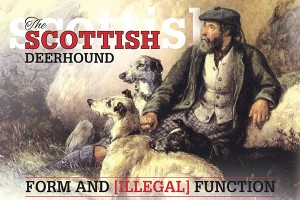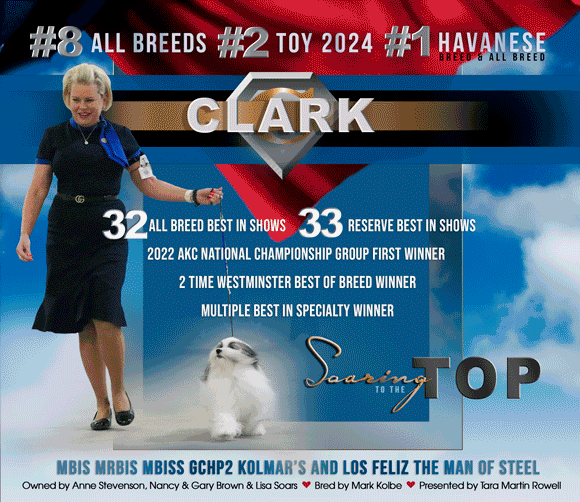The Scottish Deerhound: Form And [Illegal] Function
Click here to read the complete article
116 – April, 2024
 By Barb Heidenreich (“Fernhill”)
By Barb Heidenreich (“Fernhill”)
A. The Dilemma
If a breed’s original function is illegal, as a preservation breeder, breed judge, or judge’s mentor, how can you understand and evaluate how form follows function? This dichotomy has to be addressed in many breeds, including the Scottish Deerhound. For some, it may mean function is now irrelevant; who cares? This would ignore, however, the American Kennel Club’s (“AKC”) mission of “promoting the sport of purebred dogs and breeding for type and function” and a breed standard’s purpose, as described by Frank Kane, member of the Kennel Club’s (“KC” (UK)) Breed Standards and Stud Book sub-committee, which is to serve as “the guideline which describes the ideal characteristics, temperament and appearance … and ensures that the breed is fit for function.”
The KC changed, and the Federation Cynologique Internationale (“FCI”) recognized in 1986, a simplification of the original breed Standard published in 1892. Then, in part, after a 2008 BBC One investigative documentary, Pedigree Dogs Exposed, highlighted concerns over the health of pedigree dogs, wording was added (2009-2012) to ensure that lack of functionality became a serious fault: “any departure from the foregoing points should be considered a fault and the seriousness with which the fault should be regarded should be in exact proportion to its degree and its effect upon the health and welfare of the dog and on the dog’s ability to perform its traditional work” [FCI emphasis].
In the case of the Scottish Deerhound Club of America (“SDCA”), it voted at its Annual General Meeting in 1988 to maintain the original 1892 Standard plus its 1914 changes, that it had imported from the KC in 1935. Standards do change, so knowing and understanding the evolution of a breed standard is critically important. Scottish Deerhounds today are now in the ironical position of having a Standard that provides a minimum height for males of 30 inches/76.2 cm, while in the original 1892 Standard, 30 inches at the shoulder was the maximum for a functional Deerhound. It’s an interesting dilemma. Fortunately, many breeders still place a high value on meeting both field performance qualifications and show ring recognition–clearly the route for longevity, breed health, and preservation of breed type. Breeders, judges, and judges’ mentors of the Scottish Deerhound, and likely all breeds, should: (a) understand breed history through written records, art, and photographs; (b) understand the changes made to the breed standard over time; and (c) engage in activities available today that test functionality. The purpose of this article is to assist with these objectives.
B. Form and Function through Historical Authorship and Art
Click here to read the complete article
116 – April, 2024

Short URL: https://caninechronicle.com/?p=284091
Comments are closed











